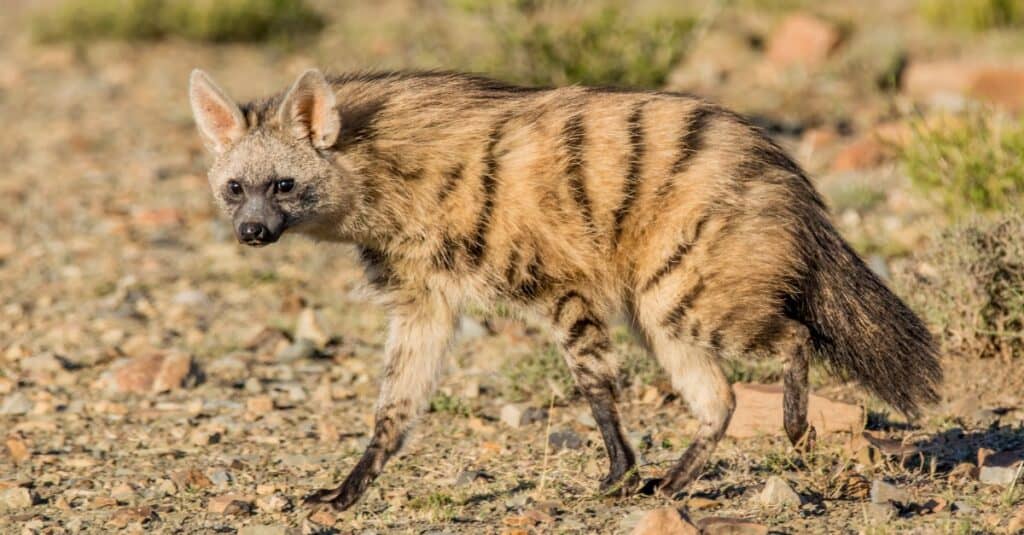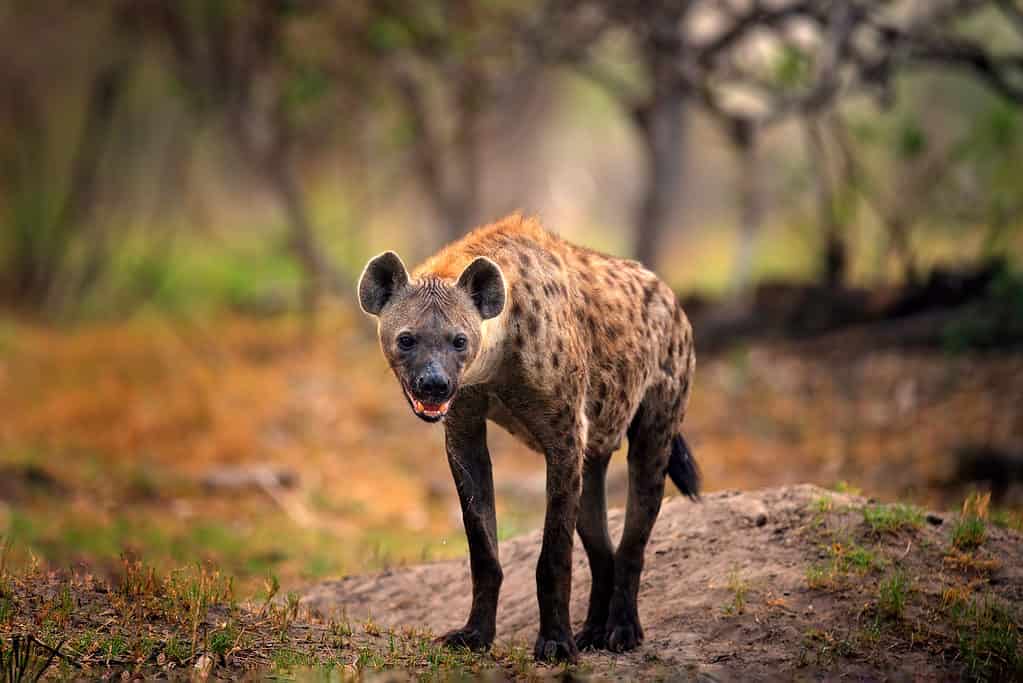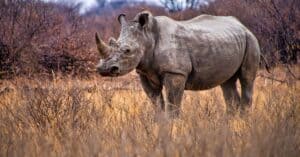The phrase “laughing like a hyena” is heard worldwide, but do hyenas laugh, and if so, why do hyenas laugh? Many people have studied hyenas and the reason for their laughter. However, it has been established that their unique sounds are not a laugh but more of a bark. Also, they do not make these sounds because they are amused. Hyenas actually use these sounds to communicate with each other. Additionally, they use barking to express excitement, fear, and frustration. Hyenas will be most vocal when hunting or feeding, usually in packs.
Why Do Hyenas Laugh?

Many people have studied
hyenas
and the reason for their laughter. However, researchers have established that their unique sounds are not a laugh but more of a bark.
Image: Thomas Wong, Shutterstock
©Thomas Wong/Shutterstock.com
The sound that hyenas make may sound like laughing to humans, but they use these sounds to let each other know that an attack has occurred or a pack member has made a kill. For example, if one hyena has made a kill and is not ready to share yet, they will make a barking noise that sounds like laughing to let one or more hyenas know. Also, maybe one pack member has made a kill and is not sharing yet. The other hyenas will express their frustration of not getting to eat by “laughing.”
There are many kinds of species of hyenas, and of course, they all have their own unique calls and sounds. However, there is only one species that makes the laughing sound, and that is the spotted hyena (Crocuta crocuta). This sound has now become synonymous with all hyenas. The pitch of a hyena’s laugh can change depending on the animal’s social status. Interestingly, hyena packs are matrilineal, which means that females lead the pack and are dominant. Therefore, as there is intense competition for food and males are subordinate, they laugh more often and tend to have a higher pitch.
Do All Hyena Species Laugh?
There are four species of hyena, and no, not all of them laugh. They all have different calls and sounds that they make:
- Spotted hyena: The spotted hyena is the only one that “laughs.” They are the largest and the loudest of the hyena species.
- Striped hyena: The striped hyena does not laugh and is the smallest of the hyena species. This hyena makes use of soft growls and grunts.
- Brown hyena: These hyenas do not laugh and are the rarest of all the hyena species. They are not often vocal, but when they are, they use squeaks, growls, and grunts that no one can hear from a distance.
- Aardwolf: People also call this species of hyena a civet hyena or ant hyena; they only eat insects. It looks like a skinny striped hyena, and they do not laugh. Instead, they make use of barking, clucking, and roaring sounds.

The aardwolf only eats insects. It looks like a skinny striped hyena, and they do not laugh.
©iStock.com/Catherine Withers-Clarke
Do Hyenas Really Laugh?
The answer to this question is no. Hyenas do not laugh. The spotted hyena might sound like it is laughing at us. However, to consider it a laugh, there must be emotion like joy or amusement involved, and when hyenas make these sounds, there is not.
What Does a Hyena Laugh Communicate?
Why do hyenas laugh? Hyenas make use of different types of sounds to communicate various things. These things can include submission and warnings; each hyena’s sound differs depending on age and rank. Examples include:
- Low-pitched call: Can communicate aggression, especially when it is loud.
- Pitch of the call: Signifies the age of the hyena.
- Frequency variation: Conveys the social rank of the hyena.
- High-pitched calls: Communicates fear, warnings, and submission.
Meaning of Different Vocalizations
- Whoop: Can be between 6 to 15 calls that can last between 30 seconds to 2 minutes. It is a short “whoops” series with an “oo” tone and can be heard more than 3 miles away. Known as one of the most impressive sounds hyenas make, it doesn’t mean anything and is done without any trigger.
- Fast whoop: Almost like the whoop, but it is higher pitched and has shorter gaps in between. This is used to let the pack know they will try to steal a kill from another pack of hyenas or even lions.
- Grunt: A grunt is a soft growl lasting a few seconds. It means a quiet warning to any unwanted hyena guests.
- Groan: Almost like a grunt, but with a higher pitch like an “oo.” This is used in a friendly meeting of hyena groups.
- Giggle: The giggle is loud and high-pitched, sounding like “hee-hee-hee.” One of these can last up to five seconds. This is what hyenas do when they are fleeing an attack.
- Yell: Lasting only a few seconds, a yell is a high-pitched call that hyenas let out when another animal bites them.
- Low: Somewhat like a groan, but lower-pitched. Similar to the fast whoop, but not as likely to attack a rival predator.
- Growl: This is like a rattling sound that lasts only a few seconds. The tone is an “oh” and “aa.” This is used just before a hyena attacks.
- Soft grunt-laugh: Fast, low-pitched grunts that can last several seconds. Hyenas will use this when attacking or running away from predators.
- Loud grunt-laugh: Louder than the soft grunt-laugh and can last more than five minutes. They use this sound when meeting lions or other hyena packs.
- Whine: Used by hyena cubs when feeding or nursing, this is like a loud, rapid sound with an “ee” tone.
What Does “Laughing Like a Hyena” Mean?
People use this term when describing someone who laughs loudly, foolishly, or hysterically. After listening to a hyena “laugh,” it is easy to see where the saying comes from, as they sound like they are laughing out of control. However, even though this simile paints a very visual picture, it is inaccurate, as a hyena does not actually laugh.
The Spotted Hyena
This animal roams the savanna of eastern Africa and is considered a scavenger, as it does not leave a scrap of food behind. Out of all the hyena species, the spotted hyena has the most powerful jaws, and in less than 30 minutes, they can kill a 400-pound zebra and devour it, fur, bones, and all.
A dominant female will rule the roost in hyena packs, with the males at the bottom of the food chain. Unfortunately, because of the narrow shape of the female’s uterus, 60 percent of her cubs will die during birth. Then, if she has more than two cubs, the fight for milk will begin, as she only has two nipples. The battle for food will not end there, even as adult hyenas will fight each other for food. When the spotted hyena does this, it is heard over eight miles away, as they will “laugh.”

Out of all the hyena species, the spotted hyena has the most powerful jaws, and in less than 30 minutes, they can kill a 400-pound zebra and devour it, fur, bones, and all.
©Ondrej Prosicky/Shutterstock.com
Do Hyenas Hunt?
Spotted hyenas are known as scavengers. However, they scavage less than a third of their total food. They are actually more of a predator than cheetahs, leopards, and lions. Hunting is not an easy task in Africa, as they have to compete with, among others, lions. However, if hyenas hunt in groups, they have a 20 percent higher chance of success.
When they catch their prey, the males typically eat last and get the scraps left over. Then, when males reach the age of two and are sexually mature, they will leave their pack to find females and form a new pack. However, females are not always easy to convince. It can take up to two years for females to accept an unknown male into their pack. When it comes to their trademark, “laugh” can be heard often during breeding season. This is not because the hyenas are aggressive. It is a way of communicating and expressing excitement.
The photo featured at the top of this post is © Ondrej Prosicky/Shutterstock.com
Thank you for reading! Have some feedback for us? Contact the AZ Animals editorial team.






